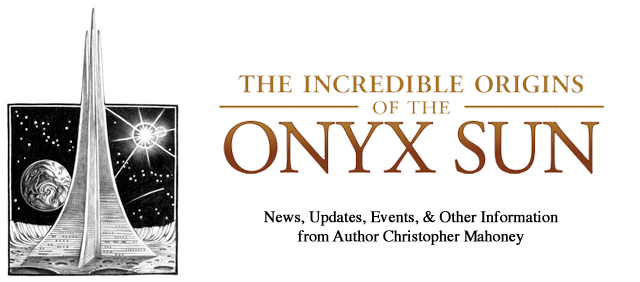I'm probably being too formal about this, but after I selected Rudy, I wrote up my requirements for the return postcard I want to include in my query letters to agents. I think my hour-long Caltrain ride from my house in Menlo Park to my job in San Francisco is becoming the most productive part of my day, as that's when I seem to get stuff like this done!
Anyway, I thought this might be interesting to any other writers interested in finding an artist to do something similar. I took this template from similar product requirements documents I have used in my other, daytime, paying job.
Onyx Sun Postcard Requirements
Objectives:
- To create a postcard potential agents will use to indicate their interest in reading more of the manuscript The Incredible Origins of the Onyx Sun.
- To produce a creative piece as a prototype to creating the jacket art and other design collateral.
Now that the Onyx Sun manuscript and major revisions are complete, the next stage in getting the book published is for me to find an agent. This involves a fairly lengthy process whereby I send query letters to agents whose focus is on representing young adult (YA) writers. Query letters are typically 1-2 page solicitations to agents that describe the story, introduce the broad plot and characters, build excitement, and (hopefully) interest the agent enough to request a complete manuscript. An example query letter is attached. The ultimate goal is for the agent to agree to represent the author and his/her work to major publishers. Most major publishers today accept manuscripts only from respected agents they often already know.
Process:
The entire query letter process can take 1-3 months per agent. Typically, the best agents get thousands of query letters per year and can only represent a very select few. Most reputable agents request they be the only person reviewing the manuscript at the time. There is unfortunately no way to speed this process up. However, if I am denied by my top picks for agents, I may solicit the rest of the industry simultaneously.
Detail:
The postcard is an item that will be included with the query letter. It will include postage and be addressed back to me at:
Christopher Mahoney
Street Address
San Francisco, CA 94133
On the front of the postcard will be a graphic representing the characters, story, and – most of all – excitement of the story The Incredible Origins of the Onyx Sun. On the back of the card, will be my return address, an area for postage, and an area where the agent can check a box and indicate that he/she is/is not interested in seeing more.
Copy:
The text for the back shall be written from the agent’s perspective and state:
Thank you for your recent letter requesting representation for your young adult novel, The Incredible Origins of the Onyx Sun. At this time:
I am very interested in reading more. Please send me the entire manuscript.
I am interested, but need more information first. Please send me a few chapters
and a more detailed synopsis.
I am not interested, but thank you for your inquiry.
Design:
- The design should follow these motifs, in order of priority:
- True to the visuals of the book
- Exciting
- Commercial (think: more Harry Potter artwork than comic book)
- Art-deco
- Space-age, but accessible and understandable to people who are not necessarily fans of science fiction
I can handle the production of the piece. This project is primarily focused on you delivering the artwork for the cover in both a high-resolution electronic format, like EPS, PSD, etc. and by sending me the actual artwork.
Next steps:
Before you commence Rudy, let’s do the following:
- Have a phone conversation around:
- What visuals grabbed you in the book
- What you think about in existing literature or art that reminds you of the theme of Onyx Sun
- What you are seeing for design:
- What is the “theme”?
- Who are the major characters to be shown?
- What are the major objects to be shown?
- Your impression of the Harry Potter book jackets and how we can borrow some of their success.
- How we fit the book title on the postcard. What is the font & other treatment?
- Talk about budget, payment terms, and timeframe.
Kalamazoo!

Christopher
